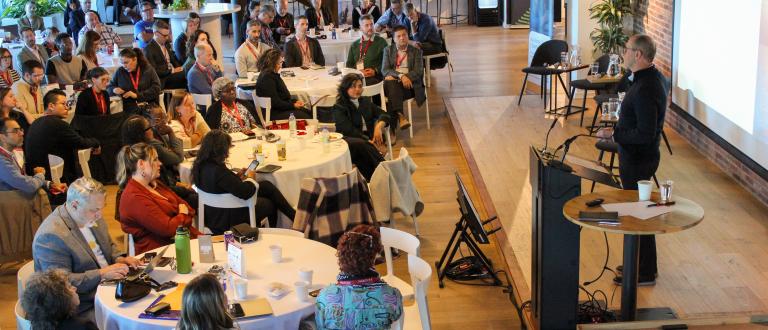360° SPONSORED CONTENT
Employees and volunteers are the secret weapon behind every nonprofit’s success. While larger nonprofits can often invest substantial amounts in Human Resources (HR), for smaller nonprofits with smaller budgets and less resources, maintaining good HR practices can be a little trickier.
In this blog, we’ll take you through a few HR best practices that small organizations can adopt today to streamline HR management, and ensure volunteers and employees feel supported, valued, and excited to be part of your mission. To access more free HR and people management resources for your nonprofit, visit HR Intervals.
What is HR management for nonprofits?
Let’s take a moment to understand exactly what HR management involves.
HR staff and departments exist to support you and your employees, and enable everyone to do their jobs successfully.
They handle everything from ensuring your nonprofit is legally compliant and filing necessary CRA paperwork, to establishing a strong organizational culture, setting policies, overseeing recruitment, and compensation. HR management teams are also responsible for supporting, training, and evaluating staff.
Besides these core functions, nonprofit HR teams can also have the responsibility of recruiting and managing volunteers, and ensuring both volunteers and staff remain committed and driven by the mission of your organization.
In smaller nonprofits, it’s not uncommon for many of these functions to be carried out by the executive director and/or accountant. Handling all these functions can be a daunting task - especially if HR is only one of your many other responsibilities.
So to make things easier, we’ll go through a few critical HR best practices you can implement to save time, maximise efficiency and grow your nonprofit.
HR Best Practices for Small Nonprofits
Here are 5 actionable HR best practices to help your nonprofit operate more effectively.
1. Manage Volunteer & Employee Onboarding Efficiently
Your onboarding process is the first impression for new employees and sets a baseline for employee morale and productivity. New employees arrive with expectations, excitement, and many questions. It is up to you to devise a strategy and onboarding process that introduces them to your mission, work environment, organizational policies and their new roles in a structured and efficient manner.
Small nonprofits often struggle with this, especially when there are a number of new staff and volunteers that arrive within a short period of time.
Checklists can help you save time and streamline your onboarding process. They ensure that you don’t miss critical steps during employee onboarding and can be easily tailored to different levels and types of employees. For example, volunteers might need only an hour or two of onboarding - which could involve speaking about your organization, a quick training session and then assigning them to a team. Whereas onboarding a new staff may include sessions with different teams, background, criminal record, and reference checks, and setting up their technology and email accounts.
HR onboarding software can also help make things easier by simplifying your onboarding process, saving you time and effort, and making sure you don’t miss out on anything important. If you're looking for HR software, make sure it includes onboarding checklists.
Onboarding is your first step towards a high employee retention rate - so make sure everyone is excited to be part of your organization at the end of it!
2. Make Sure to Track Vacation and Sick Leave
While vacations and days off are extremely important - they need to be planned. This becomes even more important when you’re working in a small team, as one person can have multiple responsibilities critical enough that their vacation time could affect your programs.
You can create a spreadsheet to track time off and manage employee leave requests. Check out this handy nonprofit vacation and sick leave spreadsheet to get started now!
While a spreadsheet is easy enough to start off with, it can leave room for error and can be difficult to manually calculate the leave entitlements of different employees.
This is where HR management software can help. With software you can set multiple policies for different levels or types of employees. For example, contract staff may not be entitled to any paid vacation, new staff have limited vacation days and volunteers can take unlimited time off.
With automated software, all you have to do is enter the date of joining, type of employee and their vacation and sick leave time is automatically set. Staff and volunteers can then login and request for leave, which is automatically deducted from their total - saving you the effort of calculating these manually and removing the potential for mistakes. Managers can also view everyone available on a specific date or time to easily plan and keep employees informed of important meetings and events.
3. Keep Employee & Volunteer Information up to Date
One of the most critical HR best practices to follow is ensuring you have up-to-date information for all employees and volunteer staff. This is important not only for your records but is part of your legal compliance as a nonprofit.
Make sure all employees (including volunteers) fill in their information as part of your onboarding process, so you don’t miss out on this critical step.
You can record the information in a physical form, spreadsheet or using HR management software. Software can be helpful as it acts as a central database for all employee records and can digitally store employee information, contracts and annual reviews - giving you a comprehensive history of an employee in a single glance.
For new employees, make sure you do a thorough background check and verify all their records before officially welcoming them.
You should also review information periodically. Depending on the type of information you record, you may choose to do this every quarter, annually or once every two years.
Finally - make sure all employee and staff records are safely stored. Contracts, appraisals and employee history are sensitive data and must be stored as securely as possible.
4. Foster a Culture of Transparency and Feedback
Prepare to make adjustments to any new policies or practices you introduce. Ask for feedback and listen to your employees when they give it. This will not only make employees feel heard, but also help you understand their pain points, and accurately identify and correct problems - which will eventually improve efficiency and staff morale.
Your team is also more likely to adopt new software and processes faster if they know their opinions are valued and will count towards a final decision.
You may not always want to hear feedback, especially if you’ve paid for an expensive software - but if all it’s doing is making employees unhappy and complicating simple processes, changing plans is the best thing you could do. You can also easily avoid this situation by asking for a free or discounted trial period, get employees to use the new software and see how it works with your organization first.
5. Make Sure Important Documents are Secure and Easily Accessible
Information management is one of the most essential, yet often neglected areas of HR management.
In many cases, critical information about the organization is stored haphazardly or resides with one person, making it difficult to access and share. You might also find yourself spending hours looking for the same documents every time the government or a granting body asks you for documentation. This can get even worse if staff are on vacation or leave the organization and fail to hand over documents.
HR and people management software can simplify this process, as it uses a secure central database to store important documents, like background checks, annual reviews, and contracts. This helps you easily find documents, grant access to multiple staff and cut down on the need for physical storage space. A centralised database also ensures the most up-to-date versions of documents are readily accessible and not saved on someone’s hard drive or inbox. You can also manage permissions so information is kept confidential and can be easily transferred to new HR staff or only accessed by those that require it.
Nonprofit organizations are employers just like any other business and need to ensure their volunteers and staff feel empowered and happy at work. Investing in human resource management can help ensure your nonprofit operates smoothly, with streamlined processes and improved efficiency.
Learn more about nonprofit HR and people management by exploring the HR Intervals’ knowledge base!
Guest contributions represent the personal opinions and insights of the authors and may not reflect the views or opinions of Imagine Canada.
Partner HR by Silent Partner Software is people management software designed and priced specifically for nonprofits. Manage staff and volunteer profiles, documents, and time off all in one place.




